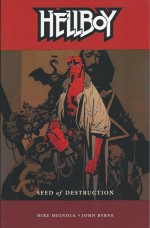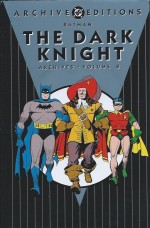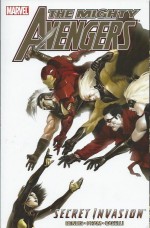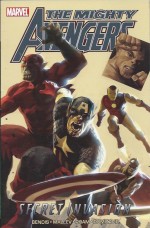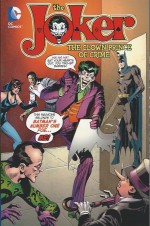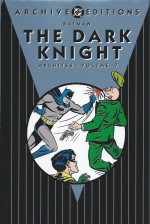
By John Ostrander & Tom Mandrake (DC Comics)
ISBN: 978-1-4012-4718-8
The Spectre is one of the oldest characters in DC’s vast stable, created by Jerry Siegel & Bernard Baily in 1940 for More Fun Comics #52 and 53, but just like Siegel’s other iconic co-creation, he soon began to suffer from a basic design flaw: he was just too darn powerful. In fact, unlike Superman, he’s already dead, so he can’t really be dramatically imperilled by anything.
Starting out as a virtually omnipotent ghost and single-minded fighter of evil, the Sinister Spirit ultimately resolved – over various returns and refits spanning more than five decades – into a succession of tormented souls bound to the merciless personification of the biblical Wrath of God. That last revelation came about thanks to a piece of inspired rethinking in a revival from the early 1990s.
The character had been rebooted and resurrected many times, but none better than this superbly incisive iteration, wherein scripter John Ostrander shifted the narrative spotlight onto the relative Tabula Rasa that was Jim Corrigan, a depression era cop whose brutal murder unleashed The Spectre into the burgeoning world of costumed heroes.
His story was a genuinely gruesome one: on the eve of his wedding police detective Corrigan was captured by the Gat Benson mob, shoved in a barrel of cement and pitched off a pier. Called back to the land of the living, he was commanded by a glowing light and disembodied voice to “confront Evilâ€.
Over the following decade in his subsequent dark crusade fighting crime and crushing demonic monsters, the Avenging Astral Angel was indisputably the most formidable hero of the Golden Age.
For most of the Spectre’s time on Earth, Corrigan had been its human face: a way for readers to glimpse the softer side of a relentless punisher of misdeeds. Ostrander’s take on the character delved deeper. For nearly five years he and artistic collaborator Tom Mandrake lent a tragic, barbaric humanity to a champion who was simply too big and too strong for periodical comics.
After far too long a wait DC recently began releasing compilations of Mandrake’s stellar run. Initial offering Crime and Judgements gathers issues #1-12 of The Spectre (volume 3 from December 1992 to November 1993) in a deliriously dark trade paperback of macabre mood and shocking suspense in which Corrigan and the Spectre finally learned the truth about their relationship…
It begins as Corrigan visits the bedside of dying thug Louis Snipe in ‘Crimes of Violence’. Fifty years previously this gunsel was one of the gang who murdered Corrigan, but before their potentially final exchange can progress they are interrupted by social worker Amy Beitermann, who gets a strange vibe off the ex-policeman…
Moments later she inadvertently witnesses his uncanny secret in action as the Spectre emerges to deliver gory justice to gangbangers perpetrating a drive-by shooting on the steps of the hospital…
She keeps the unbelievable details of the resultant bloodbath from Police Inspector Nate Kane. She knows the older man has a crush on her, and isn’t above using his doting interest to ply him with questions about a former cop named Corrigan…
Later, as the Spectre is concluding his business with Snipe, somewhere in the city, a blood-spilling serial killer takes his latest victim and Corrigan once more questions the point of his existence.
Half a century of punishing the guilty and nothing has changed…
‘Crimes of Passion’ opens with the Ghostly Guardian drawn to a house where a repeating phantom constantly relives her own murder. When she refuses to disclose any details of the crime or perpetrator Spectre reacts with typical furious overkill…
Elsewhere Amy is entering the storefront of fortune teller Madame Xanadu. Her enquiries have traced private eye Corrigan to an office in the building, but an abrupt meeting with the sultry seer proves more than she can handle after the sorceress summarily demands she find Corrigan for her…
The driven spirit they’re pursuing has been just as inquisitive. Unfortunately his questioning of the unquiet ghost’s husband, lover and sister leads to nothing but death and damnation for all the wrong people…
And at the docks Nate Kane inspects the site of the latest atrocity attributed to “the Reaver†but finds himself unexpectedly encumbered with two bodies: one of them encased in cement and in a fifty year old barrel…
‘Crimes and Punishments’ finds Amy visiting Kane at the Precinct house. Poking around, she is aghast to find a concrete corpse and beyond words when she sees it has Jim Corrigan’s agonised face…
Across town commercial artist Danny Geller is thinking about passion and the kind of woman he likes, but the Spectre is busy, or at least Corrigan is.
Having caused the suicide of an innocent, the human half of the Astral Amalgamation is in need of confession and seeks out Amy. He can’t understand why, but Jim is inexplicably drawn to her…
It’s exactly the wrong moment for a street gang to jump them and the Spectre’s revolting response-in-kind utterly disgusts the stunned social worker. When she questions why such violence is necessary, Spectre mystically shows her Corrigan’s savage childhood with an abusive, travelling-preacher father and later how the cop he became met his eventual end.
Although that panorama is too awful to bear, Amy takes some solace in seeing how happy Jim once was with his fiancée Clarice Winston…
The revelatory visions conclude with ‘Crime and Judgment’ as Corrigan re-experiences his meeting with God’s Will in Limbo. Amy intangibly observes his mission laid out again and realises the newly dead man missed something the first time: the Voice actually saying “Confront Evil. Confront and Comprehendâ€â€¦
Flashing back in time to the moment the Spectre began, Amy watches as Clarice is killed and how Corrigan dragged her back from Heaven. His beloved lived again… but she shouldn’t have…
Challenging the Spectre only causes him to turn his excoriating gaze upon Amy. He probes and exposes her greatest guilt. Once she was married to an unfaithful man. When she caught her spouse in his lustful betrayals she spitefully reacted just like him and unknowingly passed on the killer contagion he had afflicted her with to many of her one-night partners.
In her own eyes she is every inch a killer too…
However when the aroused Spectre seeks to administer judgement, Corrigan rises to resist his other half and, after a tremendous struggle, a deal is struck…
A new story arc begins with a road accident that leaves a kidnapper dead before the missing child can be found. With no hope remaining, Amy asks Jim for specialised help and the detective follows the abductor’s soul to its reward in The Pit. Ignoring his own justly-suffering father, Corrigan probes deeper into the Abode of the Damned and meets again Shathan the Eternal. Their epic battle triggers ‘A Rage in Hell’ before the Ghostly Guardian gets what he needs and the child is saved…
The Devil landed a last telling blow, however, citing the legend of how a demonic Prince of the Damned escaped Hell. This Spirit of Wrath volubly and piously repented and was bound to a human. Together they roam Earth, doing Heaven’s work. The story deeply unsettles the Spectre…
With uncomfortable suspicions of infernal taint destabilising his usually implacable composure, the Ghostly Guardian seeks out Amy. Although her condition has forced her to avoid intimacy with guys like poor Nate, she feels comfortable in the arms of a dead man, and takes the opportunity to talk Jim into trying to ameliorate his alter ego’s excesses. The inconclusive initial results are seen as Spectre goes on a rampage against a succession of callous casual murderers and greedy gangbangers in ‘The Bleeding Gun’.
Greater forces are in play, however. Xanadu, urgently seeking her ghost lodger, unleashes magic forces against uncooperative Amy even as Danny Geller makes another killing. Every day he’s getting closer to the one woman he really wants…
With Jim and Amy trapped in a fantastic realm, ‘Vision and Power’ reveals that whilst Xanadu was sheltering Corrigan after his latest resurrection, she began tapping tiny slivers of the Spectre’s mystic energies and has become addicted. Taunting her victims by claiming this magic could even cure Amy – something the Spectre would never allow – the seer then steals all that arcane might but is promptly overwhelmed by the force of the mission underpinning the power…
With Xanadu on a brutally bloody rampage of distorted judgment and punishment, Corrigan – free and free-thinking for the first time in decades – has no choice but to convince her to surrender the infinite force before picking up his burden once again…
The second act of Shathan’s vengeance begins when his diabolical lieutenant Azmodus – carried back to Earth in the wrathful Spectre’s wake – begins possessing mortals and sowing destruction. Nate, meanwhile, discovers all the Reaver’s victims were HIV-positive like Amy and gets an uncanny inkling of what’s really going on when he finally realises the ex-cop she was asking about and the concrete corpse both have the same face as the creepy new guy she’s been seeing…
When he confronts them his ‘Righteous Anger’ leads to a shattering series of further revelations…
Kane learns ‘No Good Deed Goes Unpunished’ as news of the HIV angle goes public and he’s made the police’s scapegoat for their failure to catch the Reaver. As the Spectre is dragged from Amy’s side when body-hopping Azmodus begins a campaign of spectacular slaughter, the Astral Avenger is trapped by his own zealousness within the demon whilst it continues its appalling kill-spree…
Geller too has been busy and although his body-count is far less impressive it has a single purpose. All this time he’s been hunting the harlot who infected him with a vile death-sentence and now he’s found her. The ‘Unforgivable Acts’ by all the players then continue with the restored Xanadu pondering Amy’s destiny, well aware that not even the Spectre is mighty enough to foil Fate.
The Supernal Spirit has other ideas however and follows the killer’s latest victim to the Gates of Heaven, determined to glean the Reaver’s identity. Unfortunately Archangel Michael won’t permit that and the Spectre finally finds a foe he cannot defeat…
‘The Deepest Cut’ begins the end as cashiered Nate Kane – who has pluckily stationed himself outside Amy’s home – also falls to the Reaver, but the inevitable attack is delayed once Azmodus arrives.
The devil has been gathering power with each possession and bloodbath but now he has found the perfect host in Danny Geller. Drawing the Spectre into the Greater Realms for a catastrophic final confrontation, Azmodus leaves Danny enough autonomy to fulfil his dark dream and deal Amy her ‘Final Fate’…
The physical and ethereal demons have both made the same mistake, however: underestimating the victim’s will to live, Madame Xanadu’s desire to atone and Nate’s dying wish to save the woman he loves…
And as always the Spectre will be there at the end to scourge the truly guilty…
With a stunning cover gallery by Mandrake, Glen Fabry, Sandy Plunkett, Charles Vess, Garry Leach, Dan Brereton, Matt Wagner, Michael Wm. Kaluta, Greg Hildebrandt & Bryn Barnard, this tome offers a powerful and deviously convoluted tale that goes beyond the genre’s usual cause-&-effect, calamity-&-rescue mode to examine the nature of Love and Hate and Good and Evil.
Powerful, scary and often shocking, the intricate developing relationships and interactions all compel The Spectre’s mortal aspect to confront the traumas of his long-suppressed childhood as he relives his own death and the ghastly repercussions of his return.
With intense, brooding art from Mandrake, this incarnation of the character was by far the most accessible and successful and if it had launched a year or so later might well have been a star of the budding Vertigo imprint, but even as a spooky of the mainstream DC Universe it stood alone in its maturity and complexity.
This is a book no lover of grown-up super-sagas can afford to miss.
© 1992, 1993, 2014 DC Comics. All Rights Reserved.


